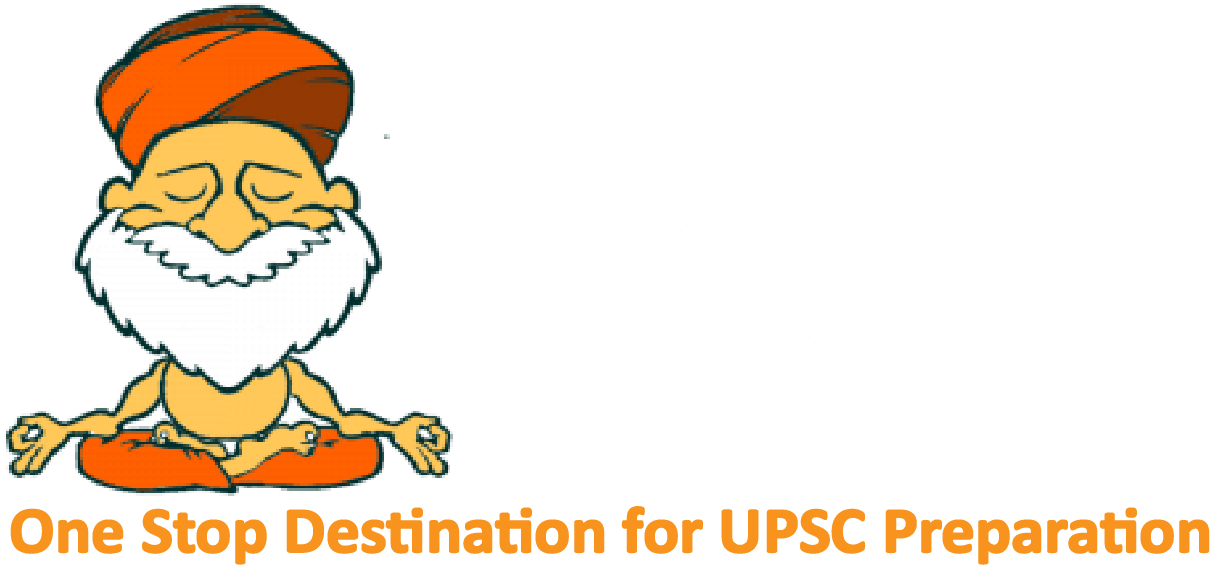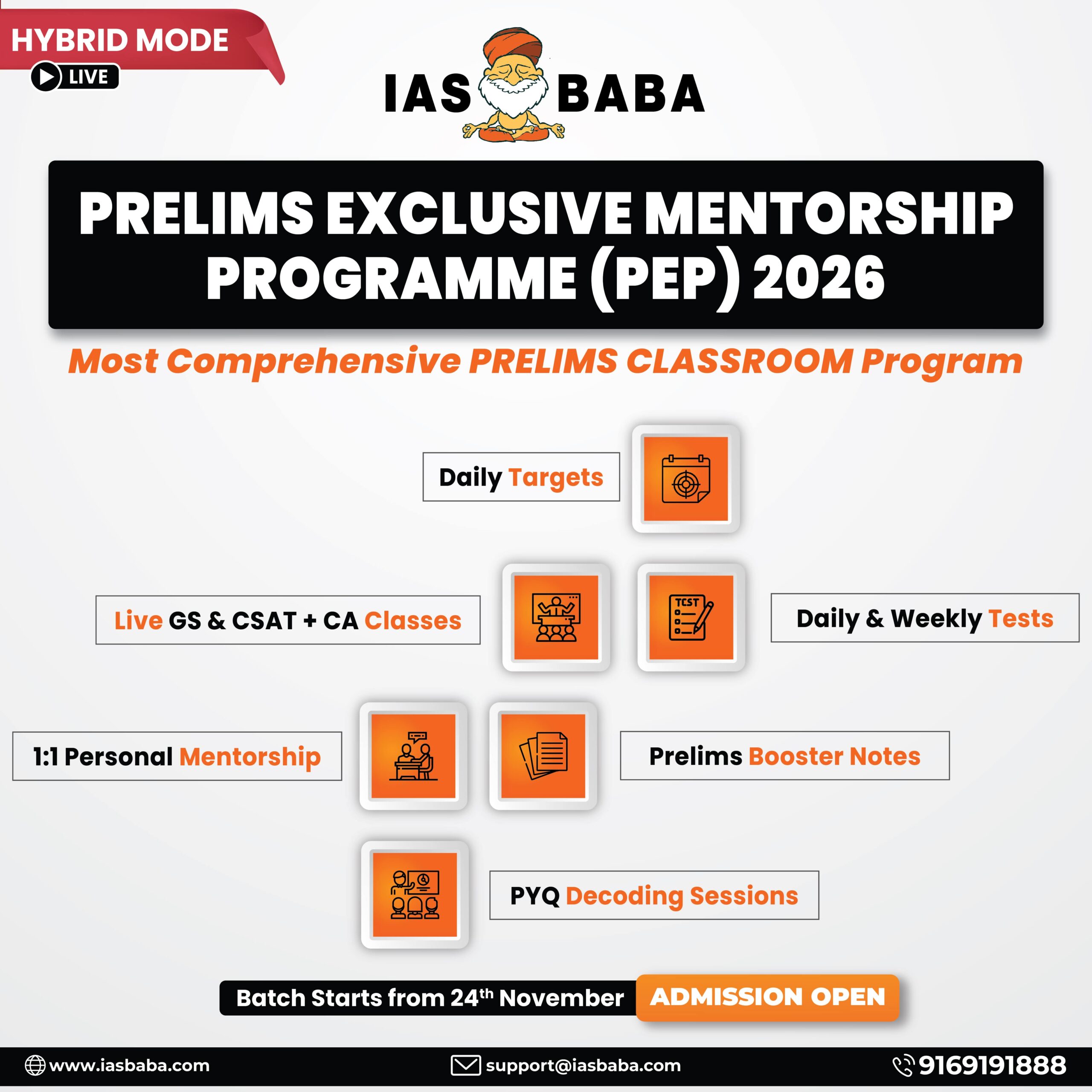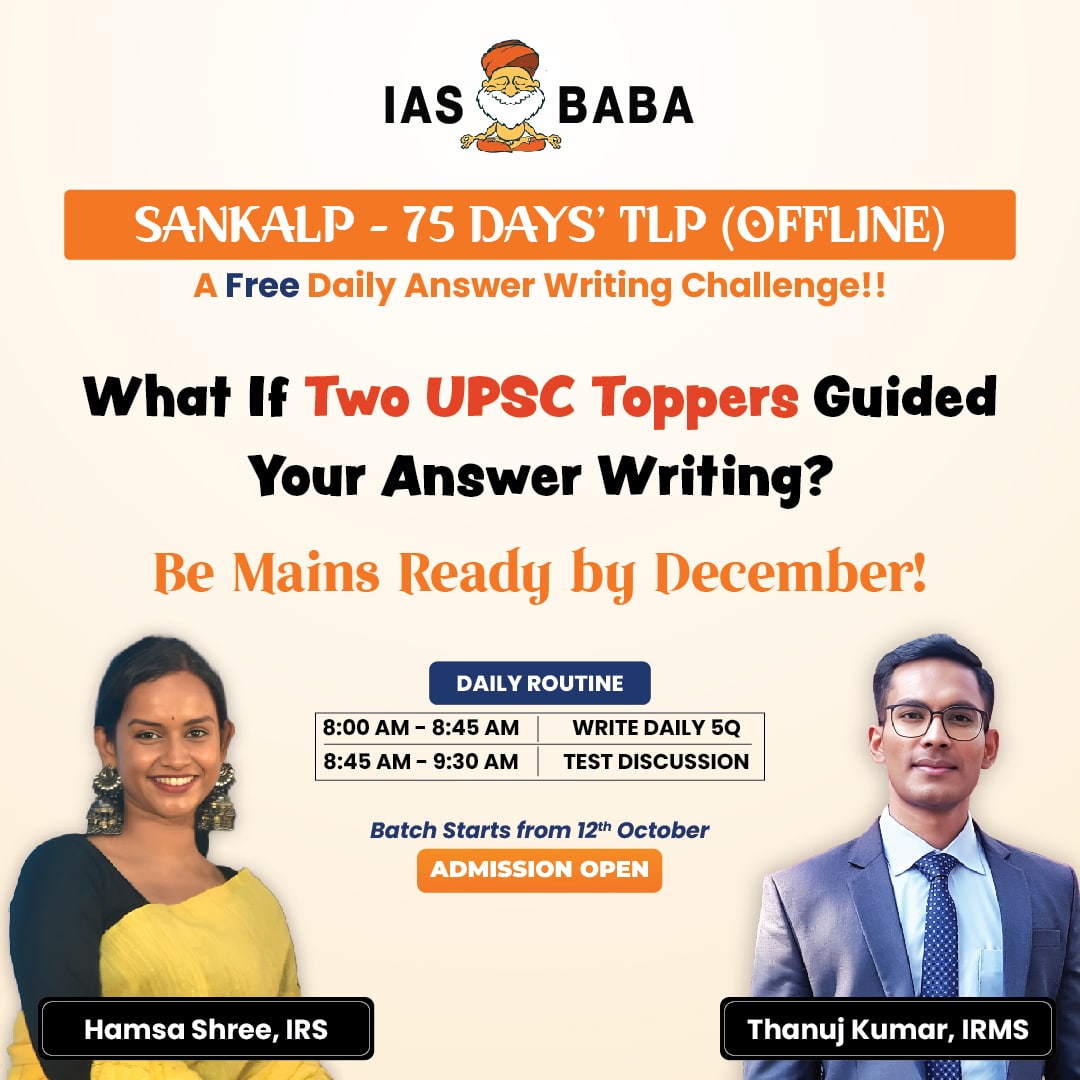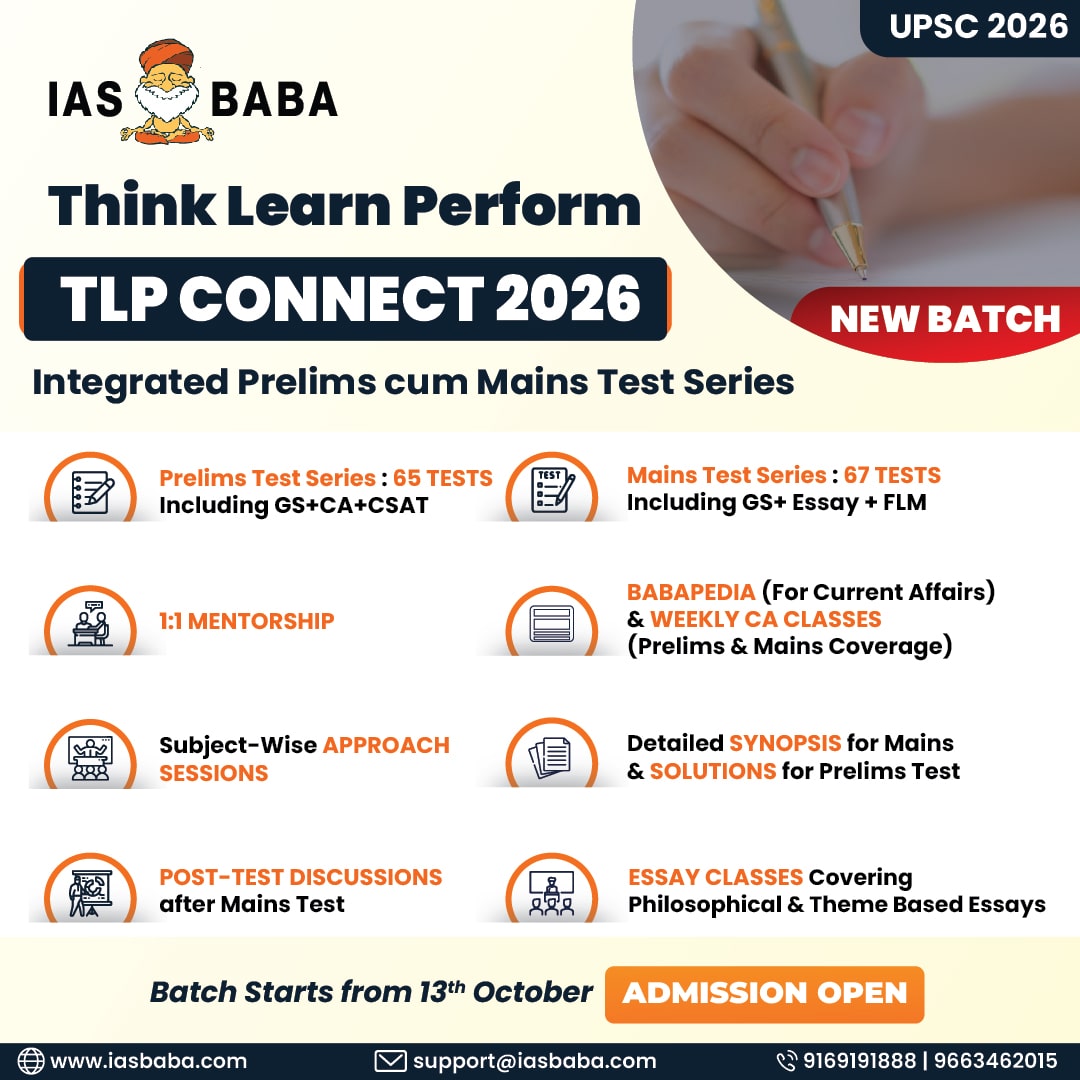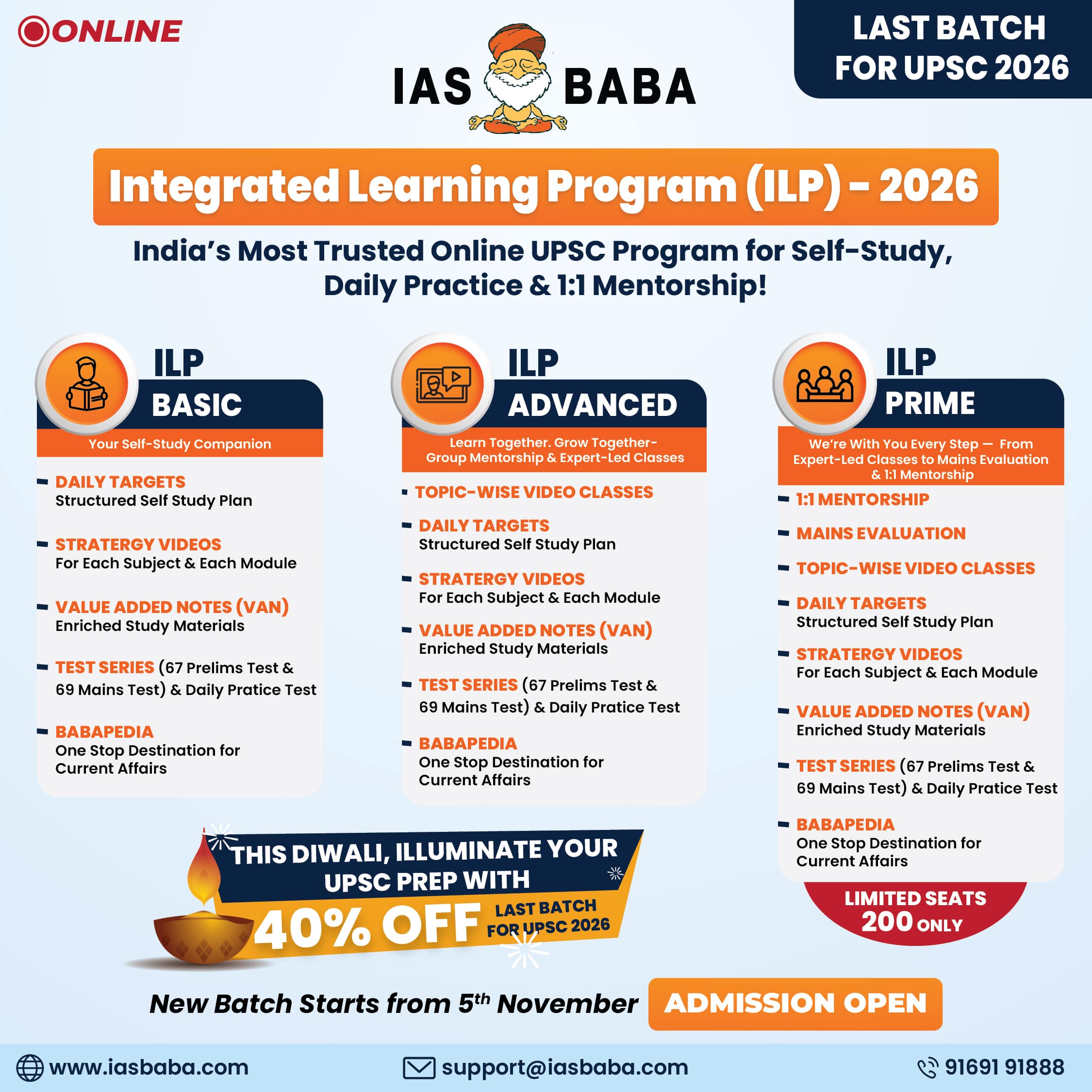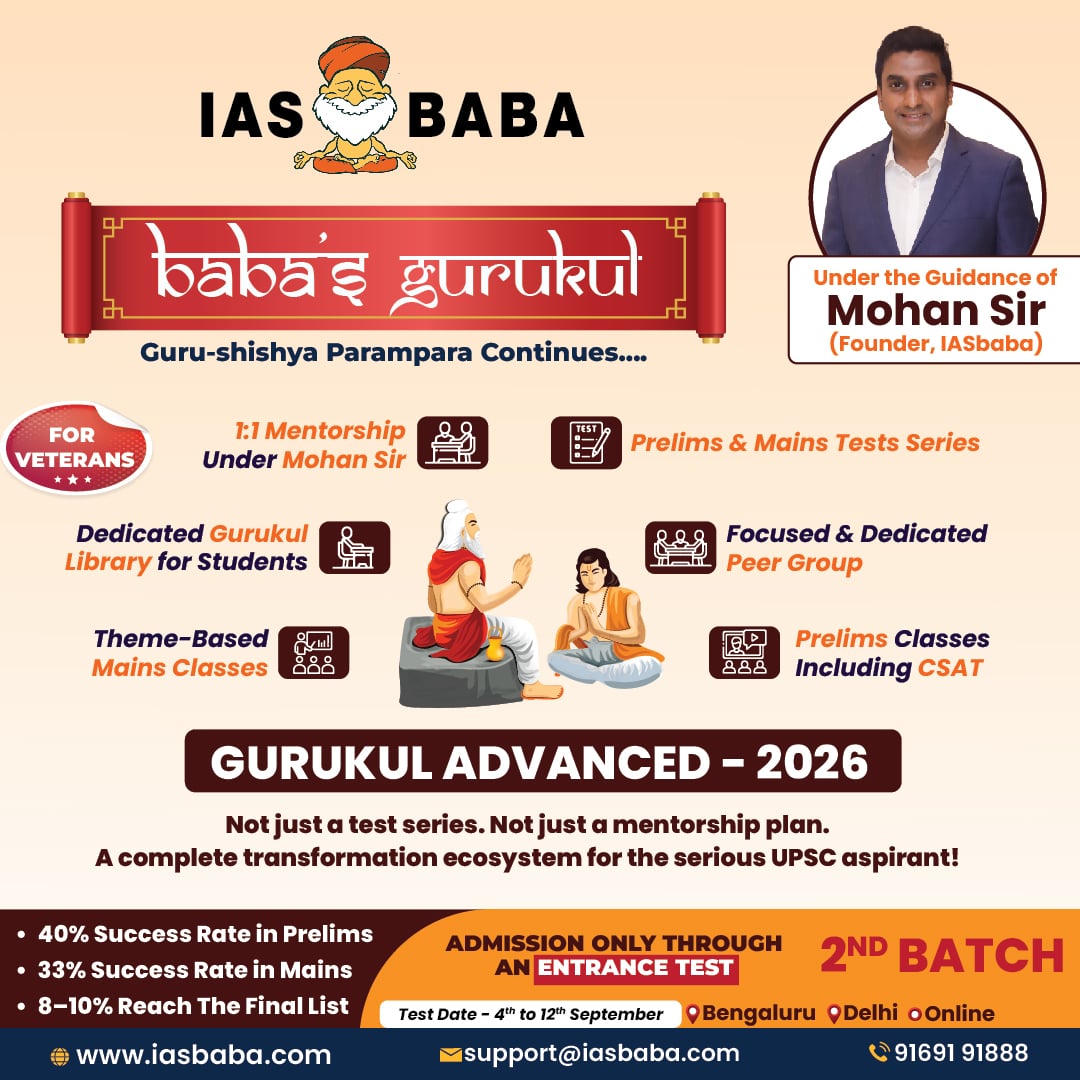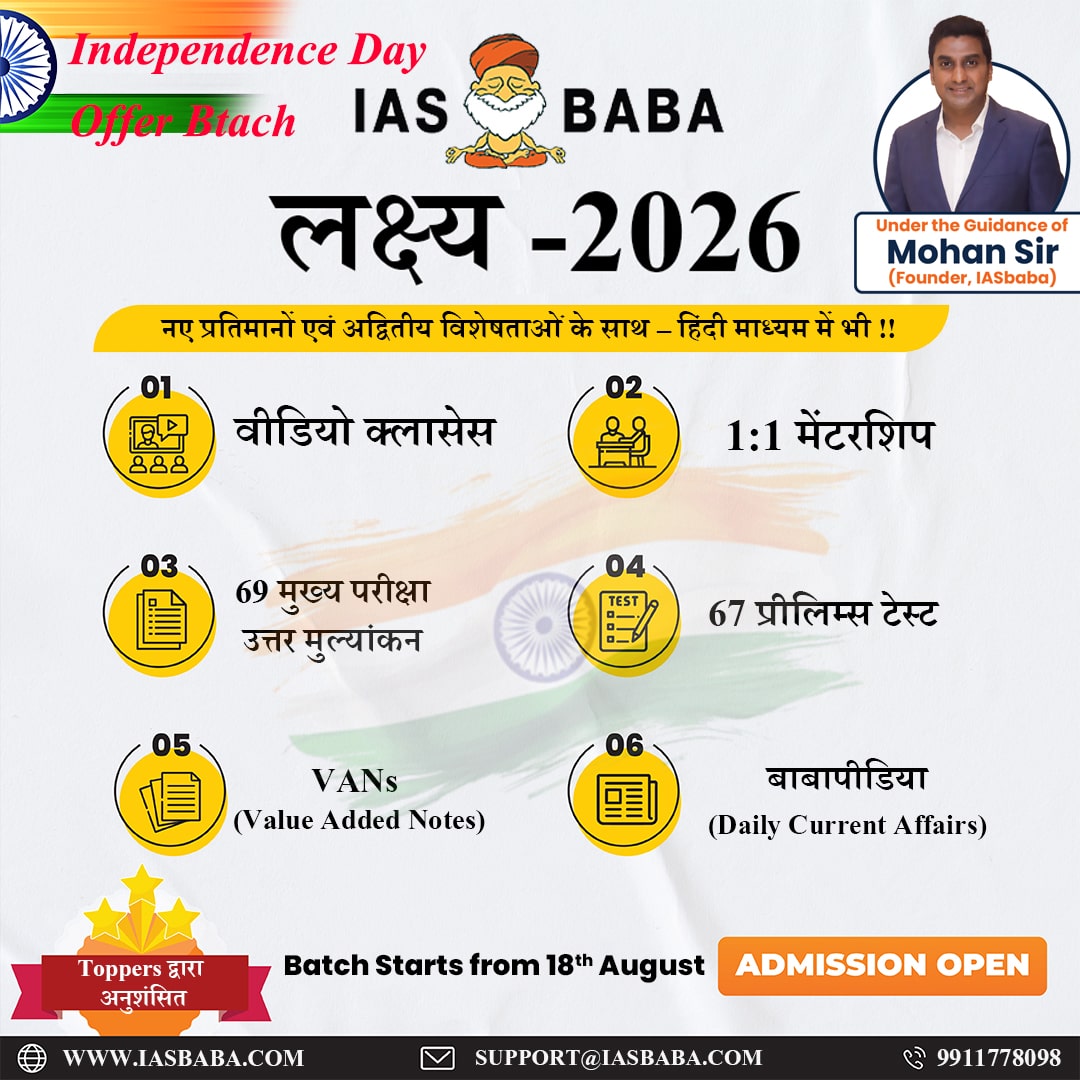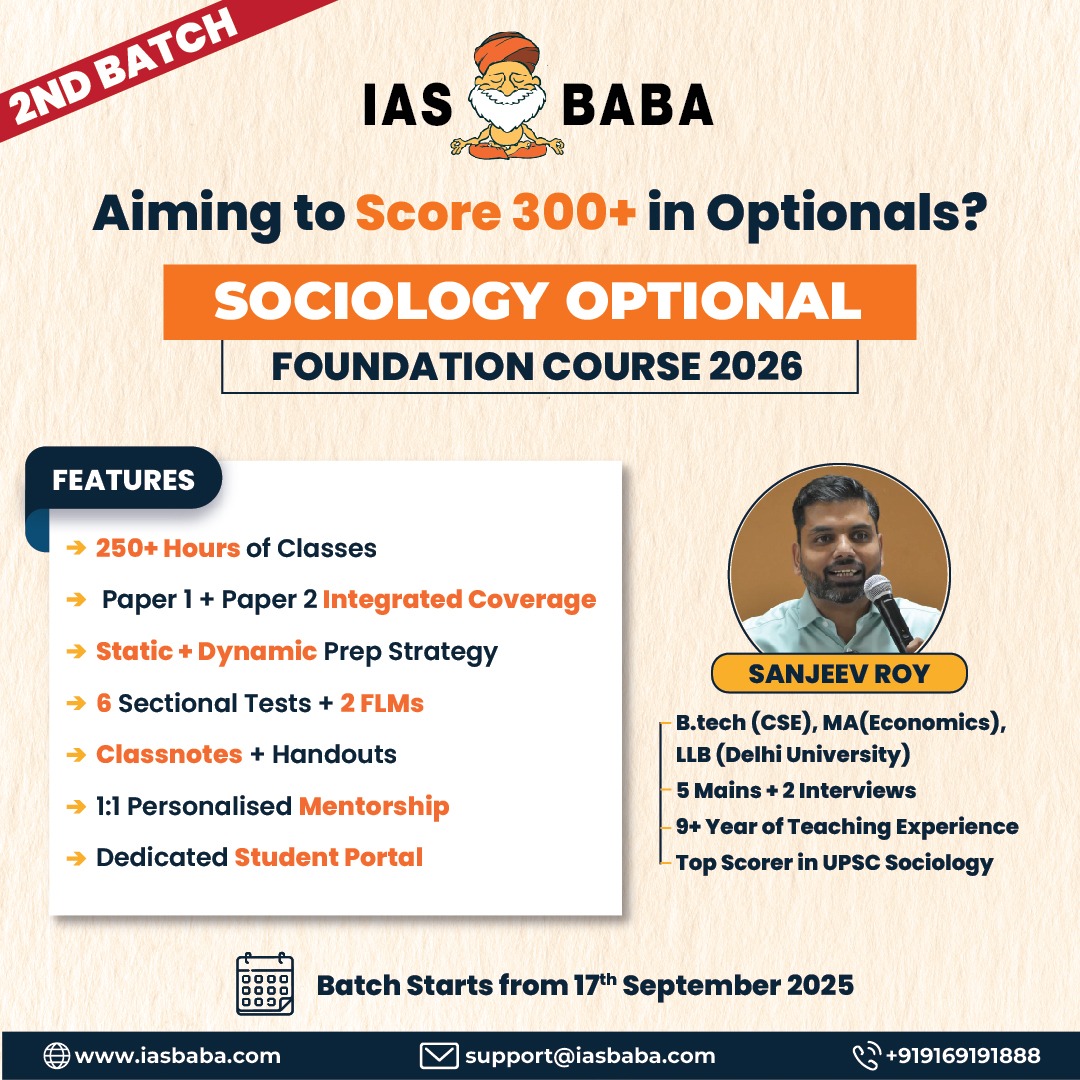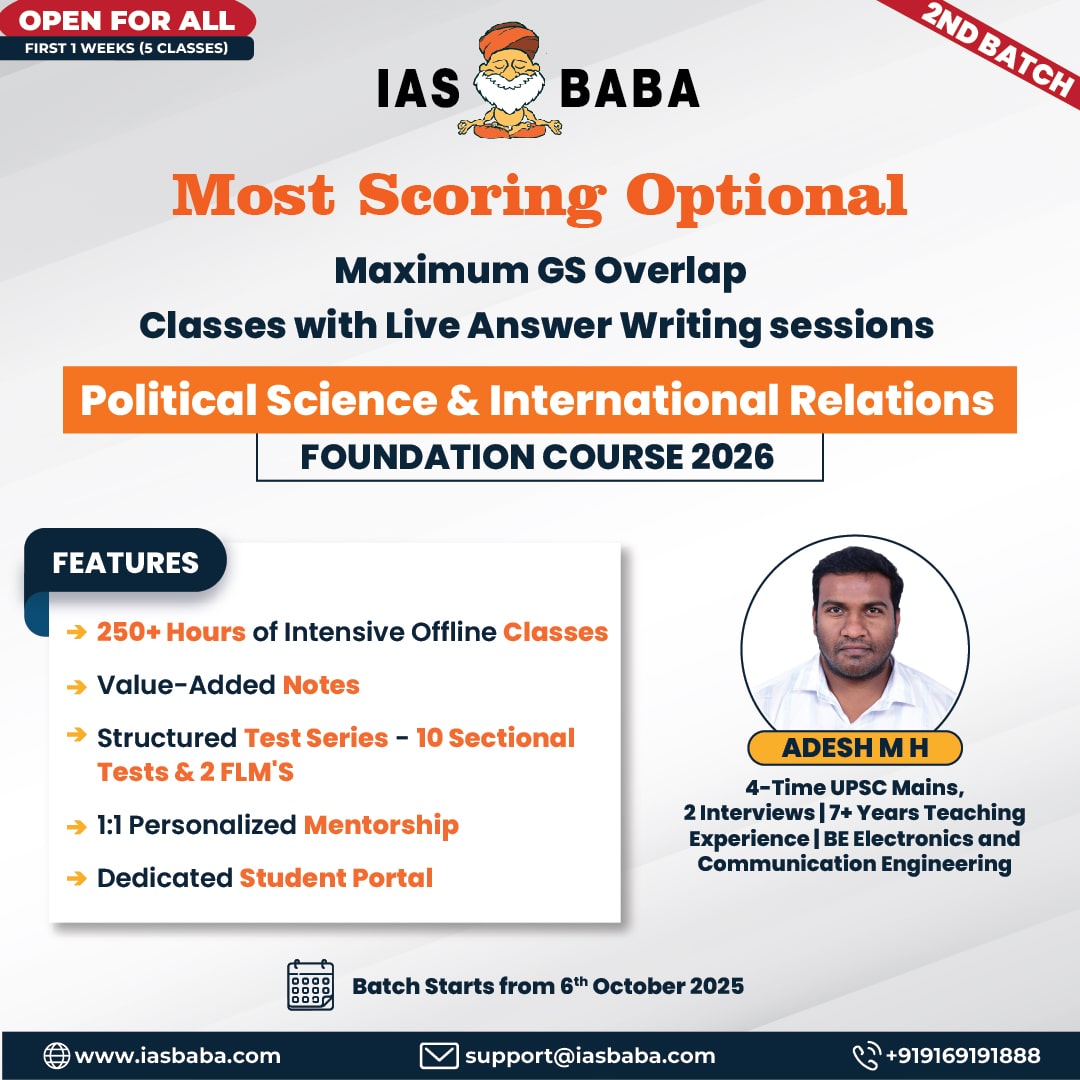IASbaba Prelims 60 Days Plan, Rapid Revision Series (RaRe)
Archives
Hello Friends
The 60 Days Rapid Revision (RaRe) Series is IASbaba’s Flagship Initiative recommended by Toppers and loved by the aspirants’ community every year.
It is the most comprehensive program which will help you complete the syllabus, revise and practice tests on a daily basis. The Programme on a daily basis includes
Daily Prelims MCQs from Static (Monday – Saturday)
- Daily Static Quiz will cover all the topics of static subjects – Polity, History, Geography, Economics, Environment and Science and technology.
- 20 questions will be posted daily and these questions are framed from the topics mentioned in the schedule.
- It will ensure timely and streamlined revision of your static subjects.
Daily Current Affairs MCQs (Monday – Saturday)
- Daily 5 Current Affairs questions, based on sources like ‘The Hindu’, ‘Indian Express’ and ‘PIB’, would be published from Monday to Saturday according to the schedule.
Daily CSAT Quiz (Monday – Friday)
- CSAT has been an Achilles heel for many aspirants.
- Daily 5 CSAT Questions will be published.
Note – Daily Test of 20 static questions, 10 current affairs, and 5 CSAT questions. (35 Prelims Questions) in QUIZ FORMAT will be updated on a daily basis.
To Know More about 60 Days Rapid Revision (RaRe) Series – CLICK HERE
60 Day Rapid Revision (RaRe) Series Schedule – CLICK HERE
Important Note
- Comment your Scores in the Comment Section. This will keep you accountable, responsible and sincere in days to come.
- It will help us come out with the Cut-Off on a Daily Basis.
- Let us know if you enjoyed today’s test 🙂
- You can post your comments in the given format
- (1) Your Score
- (2) Matrix Meter
- (3) New Learning from the Test
Test-summary
0 of 35 questions completed
Questions:
- 1
- 2
- 3
- 4
- 5
- 6
- 7
- 8
- 9
- 10
- 11
- 12
- 13
- 14
- 15
- 16
- 17
- 18
- 19
- 20
- 21
- 22
- 23
- 24
- 25
- 26
- 27
- 28
- 29
- 30
- 31
- 32
- 33
- 34
- 35
Information
The following Test is based on the syllabus of 60 Days Plan-2025 for UPSC IAS Prelims 2025.
To view Solutions, follow these instructions:
- Click on – ‘Start Test’ button
- Solve Questions
- Click on ‘Test Summary’ button
- Click on ‘Finish Test’ button
- Now click on ‘View Questions’ button – here you will see solutions and links.
You have already completed the test before. Hence you can not start it again.
Test is loading...
You must sign in or sign up to start the test.
You have to finish following test, to start this test:
Results
0 of 35 questions answered correctly
Your time:
Time has elapsed
You have scored 0 points out of 0 points, (0)
| Average score |
|
| Your score |
|
Categories
- Not categorized 0%
| Pos. | Name | Entered on | Points | Result |
|---|---|---|---|---|
| Table is loading | ||||
| No data available | ||||
- 1
- 2
- 3
- 4
- 5
- 6
- 7
- 8
- 9
- 10
- 11
- 12
- 13
- 14
- 15
- 16
- 17
- 18
- 19
- 20
- 21
- 22
- 23
- 24
- 25
- 26
- 27
- 28
- 29
- 30
- 31
- 32
- 33
- 34
- 35
- Answered
- Review
-
Question 1 of 35
1. Question
Identify the Mughal emperor who laid the foundation of a city named Dinpanah on the banks of the river Yamuna.
Which Mughal emperor is being referred to in the above Statement?
Correct
Solution (b)
Explanation:
- The second Mughal Emperor Humayun in year 1533 A.D. established the city of Dinpanah (Shelter of the Devout) on the banks of river Yamuna. In the Battle of Sirhind (1555), Sikandar Shah Suri was decisively defeated by Humayun and it paved the way for re-establishment of Mughal empire. Hence, option b is correct.
Incorrect
Solution (b)
Explanation:
- The second Mughal Emperor Humayun in year 1533 A.D. established the city of Dinpanah (Shelter of the Devout) on the banks of river Yamuna. In the Battle of Sirhind (1555), Sikandar Shah Suri was decisively defeated by Humayun and it paved the way for re-establishment of Mughal empire. Hence, option b is correct.
-
Question 2 of 35
2. Question
Consider the following statements:
- Sher Shah Suri reformed the currency system and introduced the pure silver currency known as ‘daam’.
- Sher Shah Suri has introduced the system of Dagh and Chehra to maintain robustness of his army.
- The mausoleum of Sher Shah Suri is located in Lahore.
How many of the above statements is/are correct?
Correct
Solution (d)
Explanation:
- Sher Shah Suri had reformed the currency system. He had introduced currencies known as Rupiya (made of pure silver) and Daam (made of copper). The exchange rate was based on the ratio of 40 Copper paisa per rupee and titles were inscribed on the coins in Arabic and Devanagari script. Hence, Statement 1 is incorrect.
- Sher Shah Suri had adopted the custom of chehra (having facial records of soldiers) and dagh (branded horses with an imperial sign). It was inspired from the military reforms of Alauddin Khilji. Hence, Statement 2 is Incorrect.
- The tomb of Sher Shah Suri is a mausoleum located in Sasaram (Bihar), which is considered as one of the masterpieces of Indian architecture. It is octagonal in shape and is situated in the middle of a huge pond spread over an area of 22 acres. Hence, Statement 3 is incorrect.
Incorrect
Solution (d)
Explanation:
- Sher Shah Suri had reformed the currency system. He had introduced currencies known as Rupiya (made of pure silver) and Daam (made of copper). The exchange rate was based on the ratio of 40 Copper paisa per rupee and titles were inscribed on the coins in Arabic and Devanagari script. Hence, Statement 1 is incorrect.
- Sher Shah Suri had adopted the custom of chehra (having facial records of soldiers) and dagh (branded horses with an imperial sign). It was inspired from the military reforms of Alauddin Khilji. Hence, Statement 2 is Incorrect.
- The tomb of Sher Shah Suri is a mausoleum located in Sasaram (Bihar), which is considered as one of the masterpieces of Indian architecture. It is octagonal in shape and is situated in the middle of a huge pond spread over an area of 22 acres. Hence, Statement 3 is incorrect.
-
Question 3 of 35
3. Question
Consider the following statements about Ibadat-khana established by Akbar:
- Its main purpose was to facilitate philosophical and theological discussions.
- It was opened only to the Muslim and Hindu scholars and spiritual leaders.
Which of the above statements are Incorrect?
Correct
Solution (b)
Explanation:
- The Ibadat khana (hall of worship) was the meeting house built by Mughal Emperor Akbar at Fatehpur Sikri 1575 AD to facilitate philosophical and theological discussions. Hence, Statement 1 is correct.
Its main purpose was to gather spiritual leaders from different religious bases to discuss the teachings of the respective religious leaders. It was not restricted to Muslim scholars only as spiritual leaders of Christians, Zoroastrians, Hindus, Jains and even atheists were called for discussions. Hence, Statement 2 is incorrect.
Incorrect
Solution (b)
Explanation:
- The Ibadat khana (hall of worship) was the meeting house built by Mughal Emperor Akbar at Fatehpur Sikri 1575 AD to facilitate philosophical and theological discussions. Hence, Statement 1 is correct.
Its main purpose was to gather spiritual leaders from different religious bases to discuss the teachings of the respective religious leaders. It was not restricted to Muslim scholars only as spiritual leaders of Christians, Zoroastrians, Hindus, Jains and even atheists were called for discussions. Hence, Statement 2 is incorrect.
-
Question 4 of 35
4. Question
Consider the following statements:
- The period of Shahjahan was also known as the ‘Golden Age of Mughal paintings.’
- Abul Hassan and Ustad Mansur were famous painters in the court of Shahjahan.
- The renowned Peacock Throne was originally made for Shahjahan.
How many of the above is/are correct?
Correct
Solution (a)
Explanation:
- The art of Mughal painting reached great heights during Jahangir’s reign (not Shahjahan). Jahangir was a highly skilled connoisseur of painting. Thus, Jahangir’s period was called ‘Golden Age of Mughal Paintings’. Hence, Statement 1 is incorrect.
- Abul Hassan, Ustad Mansur, Faruq Begh, Bishan Das, etc were the main artists of Jahangir’s court. Abul Hassan made a painting of Jahangir ‘s coronation. This painting is inscribed in the Jahangir’s autobiography ‘Tujuk-e-Jahangiri’ on the main page. Hence, Statement 2 is incorrect.
The Peacock Throne was a famous jewelled throne that was the seat of the Mughal emperors of India. It was originally commissioned during the reign of Shahjahan. It remained the seat of the Mughal emperors of India from 1635 to 1739. Hence, Statement 3 is correct.
Incorrect
Solution (a)
Explanation:
- The art of Mughal painting reached great heights during Jahangir’s reign (not Shahjahan). Jahangir was a highly skilled connoisseur of painting. Thus, Jahangir’s period was called ‘Golden Age of Mughal Paintings’. Hence, Statement 1 is incorrect.
- Abul Hassan, Ustad Mansur, Faruq Begh, Bishan Das, etc were the main artists of Jahangir’s court. Abul Hassan made a painting of Jahangir ‘s coronation. This painting is inscribed in the Jahangir’s autobiography ‘Tujuk-e-Jahangiri’ on the main page. Hence, Statement 2 is incorrect.
The Peacock Throne was a famous jewelled throne that was the seat of the Mughal emperors of India. It was originally commissioned during the reign of Shahjahan. It remained the seat of the Mughal emperors of India from 1635 to 1739. Hence, Statement 3 is correct.
-
Question 5 of 35
5. Question
Consider the following pairs:
Foreign travellers Rulers - I Tsing
Babur - Ibn Battuta
Humayun - Thomas Roe
Jahangir - Niccolo Manucci
Aurangzeb How many of the above pairs are correctly matched?
Correct
Solution (b)
Explanation:
- I-Tsing visited India during the reign of Harshavardhana in 7th century. He was a traveller from China who came to India because of Buddhism. Hence, pair 1 is incorrect.
- Ibn Battuta was a Moroccan traveller (1333-1347 AD) who visited India during the reign of Muhammad-bin-Tughlaq. He wrote the famous book ‘Rihala’ which is about his travels. Hence, pair 2 is incorrect.
- Sir Thomas Roe came to India in 1615 during the reign of Jahangir as an ambassador of King James I. He was England’s first official ambassador to India. Hence, pair 3 is correct.
Niccolo Manucci was an Italian adventurer and traveller. He arrived in India in 1656 at the age of 17 during the reign of Aurangzeb. Hence, pair 4 is correct.
Incorrect
Solution (b)
Explanation:
- I-Tsing visited India during the reign of Harshavardhana in 7th century. He was a traveller from China who came to India because of Buddhism. Hence, pair 1 is incorrect.
- Ibn Battuta was a Moroccan traveller (1333-1347 AD) who visited India during the reign of Muhammad-bin-Tughlaq. He wrote the famous book ‘Rihala’ which is about his travels. Hence, pair 2 is incorrect.
- Sir Thomas Roe came to India in 1615 during the reign of Jahangir as an ambassador of King James I. He was England’s first official ambassador to India. Hence, pair 3 is correct.
Niccolo Manucci was an Italian adventurer and traveller. He arrived in India in 1656 at the age of 17 during the reign of Aurangzeb. Hence, pair 4 is correct.
-
Question 6 of 35
6. Question
Consider the following statements:
- Mir Bakshi was the head of intelligence during Mughal period.
- Waqia-navis were press reporters posted in all parts of Mughal Empire.
Which of the above is/are correct?
Correct
Solution (c)
Explanation:
- Mir Bakshi was the head of intelligence during Mughal period. He was responsible for gathering intelligence and recommending people for military promotions and appointments accordingly. His position was as the head of military administration in the Mughal Empire. Hence, Statement 1 is correct.
Under Mughal administration, the intelligence officers were known as “Barids” and news reporters were called as ” Waqia-navis”. They were posted in all parts of Mughal Empire and their reports were presented to the emperor at the court. Hence, Statement 2 is correct.
Incorrect
Solution (c)
Explanation:
- Mir Bakshi was the head of intelligence during Mughal period. He was responsible for gathering intelligence and recommending people for military promotions and appointments accordingly. His position was as the head of military administration in the Mughal Empire. Hence, Statement 1 is correct.
Under Mughal administration, the intelligence officers were known as “Barids” and news reporters were called as ” Waqia-navis”. They were posted in all parts of Mughal Empire and their reports were presented to the emperor at the court. Hence, Statement 2 is correct.
-
Question 7 of 35
7. Question
Consider the following:
- The Khalsa Panth was established by Guru Nanak, the first of the ten Sikh Gurus.
- Guru Granth Sahib was compiled by Guru Govind Singh, the tenth Sikh Guru.
Which of the above is/are correct?
Correct
Solution (d)
Explanation:
- The 10th Guru and last prophet of Sikh, Guru Gobind Singh (not Guru Nanak) converted Sikhs into a military sect ‘’Khalsa Panth’’. He called the whole Sikh community as ‘’Khalsa’’. He instructed that each Sikh should have 5Ks- Kesh, Kangha, Kachha, Kripan and Kada. Hence, Statement 1 is incorrect.
- Adi Granth or Guru Granth Sahib is the sacred book of Sikhs. It was compiled by Arjun Dev (not Guru Govind Sing), 5th Sikh Guru (1581-1606). It contains preachings of six Sikh Gurus, many Hindu devotees, Kabir, Baba Farid, Namdev and Raidas. The first line of Adi Granth was written by Bengali Vaishnav poet Jaydev and the last line was written by Guru Tegh Bahadur. Hence, Statement 2 is incorrect.
Incorrect
Solution (d)
Explanation:
- The 10th Guru and last prophet of Sikh, Guru Gobind Singh (not Guru Nanak) converted Sikhs into a military sect ‘’Khalsa Panth’’. He called the whole Sikh community as ‘’Khalsa’’. He instructed that each Sikh should have 5Ks- Kesh, Kangha, Kachha, Kripan and Kada. Hence, Statement 1 is incorrect.
- Adi Granth or Guru Granth Sahib is the sacred book of Sikhs. It was compiled by Arjun Dev (not Guru Govind Sing), 5th Sikh Guru (1581-1606). It contains preachings of six Sikh Gurus, many Hindu devotees, Kabir, Baba Farid, Namdev and Raidas. The first line of Adi Granth was written by Bengali Vaishnav poet Jaydev and the last line was written by Guru Tegh Bahadur. Hence, Statement 2 is incorrect.
-
Question 8 of 35
8. Question
Consider the following:
- Akbar’s Rajput policy was combined with a policy of religious toleration.
- Though Akbar had abolished the pilgrim tax but he retained the Jizya tax, which was often considered a symbol of Muslim superiority.
- Because of the success of the Rajput policy of Akbar, the policy was carried forward by Shajahan, Jahangir, and Aurangzeb.
How many of the above is/are correct?
Correct
Solution (a)
Explanation:
-
- The Rajput policy of Akbar was combined with a policy of religious toleration. was based on forming marital alliances with Rajput kings. If a Rajput princess married Akbar’s son or grandson, it meant the Rajput kingdom had joined the Mughal Empire peacefully. The first Rajput kingdom Akbar formed an alliance with was Bikaner in 1585. Hence, Statement 1 is correct.
- Akbar’s Rajput policy was established on broad religious patience and in line with this, he revoked the not only the pilgrimage tax and later also the Jizya. Jizya was a tax imposed by Muslim kings on the Hindu citizens in exchange for their protection. Jizya was originally imposed in India by Qutb-ud-din Aibak. Hence, Statement 2 is incorrect.
- Though the Rajput policy of Akbar was successful, it was not carried forward by his successors Shajahan, Jahangir, and Aurangzeb. For example, the Jizya tax abolished by Akbar in the 16th century was reimposed by Aurangzeb in the 17th century. Hence, Statement 3 is incorrect.
Incorrect
Solution (a)
Explanation:
-
- The Rajput policy of Akbar was combined with a policy of religious toleration. was based on forming marital alliances with Rajput kings. If a Rajput princess married Akbar’s son or grandson, it meant the Rajput kingdom had joined the Mughal Empire peacefully. The first Rajput kingdom Akbar formed an alliance with was Bikaner in 1585. Hence, Statement 1 is correct.
- Akbar’s Rajput policy was established on broad religious patience and in line with this, he revoked the not only the pilgrimage tax and later also the Jizya. Jizya was a tax imposed by Muslim kings on the Hindu citizens in exchange for their protection. Jizya was originally imposed in India by Qutb-ud-din Aibak. Hence, Statement 2 is incorrect.
- Though the Rajput policy of Akbar was successful, it was not carried forward by his successors Shajahan, Jahangir, and Aurangzeb. For example, the Jizya tax abolished by Akbar in the 16th century was reimposed by Aurangzeb in the 17th century. Hence, Statement 3 is incorrect.
-
Question 9 of 35
9. Question
Consider the following statements about Dahsala system:
- It was a land revenue system developed by Todarmal, the finance minister of Akbar.
- Under this system, the revenue assessment was based on the average yield of land over the preceding 20 years.
- The land was also divided into four categories – Polaj, Parauti, Chachar and Banjar.
Which of the above is/are correct?
Correct
Solution (c)
Explanation:
- Akbar made some experiments in the land revenue administration with the help of his finance minister Todar Mal. The land revenue system of Akbar was called Zabti or Bandobast system which was further improved by Raja Todar Mal. It was known as Dahsala System which was completed in 1580. By this system, Todar Mal introduced a uniform system of land measurement. Hence, Statement 1 is correct.
- Under this system, the average produce of different crops as well as the average prices prevailing over the last ten years (not hundred years) were calculated as the land revenue. Hence, Statement 2 is incorrect.
- Under this system, the land was also divided into four categories – Polaj (cultivated every year), Parauti (once in two years), Chachar (once in three or four years) and Banjar (once in five or more years). Hence, Statement 3 is correct.
Incorrect
Solution (c)
Explanation:
- Akbar made some experiments in the land revenue administration with the help of his finance minister Todar Mal. The land revenue system of Akbar was called Zabti or Bandobast system which was further improved by Raja Todar Mal. It was known as Dahsala System which was completed in 1580. By this system, Todar Mal introduced a uniform system of land measurement. Hence, Statement 1 is correct.
- Under this system, the average produce of different crops as well as the average prices prevailing over the last ten years (not hundred years) were calculated as the land revenue. Hence, Statement 2 is incorrect.
- Under this system, the land was also divided into four categories – Polaj (cultivated every year), Parauti (once in two years), Chachar (once in three or four years) and Banjar (once in five or more years). Hence, Statement 3 is correct.
-
Question 10 of 35
10. Question
The terms ‘kamin’ and ‘khudkasht’ in the context of Medieval India were used for:
Correct
Solution (c)
Explanation:
- The landless peasants and labourers during the Mughal empire belonged to the class of people called as untouchables or ‘kamin’. And the peasants who owned the land they tilled were called ‘khudkhast’. Hence, option c is correct.
Incorrect
Solution (c)
Explanation:
- The landless peasants and labourers during the Mughal empire belonged to the class of people called as untouchables or ‘kamin’. And the peasants who owned the land they tilled were called ‘khudkhast’. Hence, option c is correct.
-
Question 11 of 35
11. Question
Among the members of Shivaji’s Asthapradhan, the person appointed to handle affairs of finance or revenue was known as
Correct
Solution (d)
Explanation:
- ‘Ashtapradhan’ was a council of eight ministers constituted by Shivaji in Maratha administration. The member appointed to handle affairs of finance or revenue was known as Amatya. Hence, option d is correct.
- All the 8 members of the ‘Ashtapradhan’ were as follows:
- Peshva (Prime Minister)
- Amatya or Mazumdar (Finance Minister)
- Waqia-Navis (like a home minister)
- Samant or Dabir (dealing with the outsiders)
- Sachiv (The official correspondence)
- Pandit Rao (The official religious officer)
- Sar-i-nabuat (army affairs)
- Nyayadhish (judiciary)
Incorrect
Solution (d)
Explanation:
- ‘Ashtapradhan’ was a council of eight ministers constituted by Shivaji in Maratha administration. The member appointed to handle affairs of finance or revenue was known as Amatya. Hence, option d is correct.
- All the 8 members of the ‘Ashtapradhan’ were as follows:
- Peshva (Prime Minister)
- Amatya or Mazumdar (Finance Minister)
- Waqia-Navis (like a home minister)
- Samant or Dabir (dealing with the outsiders)
- Sachiv (The official correspondence)
- Pandit Rao (The official religious officer)
- Sar-i-nabuat (army affairs)
- Nyayadhish (judiciary)
-
Question 12 of 35
12. Question
The provincial administration during Mughal Empire was divided (top to bottom) in the form of
Correct
Solution (d)
Explanation:
The Mughal Empire was divided into provinces, known as Subahs, each headed by a provincial governor called a Subahdar. The provinces were subdivided into districts, known as Sarkars and they were headed by Fauzdars and Amalguzars. The Sarkars were further divided into sub-districts known as Parganas, headed by Shiqdars. At the lowest level were the villages which were headed by Muqaddams. Hence, option d is correct.
Incorrect
Solution (d)
Explanation:
The Mughal Empire was divided into provinces, known as Subahs, each headed by a provincial governor called a Subahdar. The provinces were subdivided into districts, known as Sarkars and they were headed by Fauzdars and Amalguzars. The Sarkars were further divided into sub-districts known as Parganas, headed by Shiqdars. At the lowest level were the villages which were headed by Muqaddams. Hence, option d is correct.
-
Question 13 of 35
13. Question
Consider the following statements:
- Shivaji crowned himself formally at Raigarh after defeating the Mughals in the Battle of Salher.
- Shivaji assumed the title of ‘Haindava Dharmodhhaarak’ which means Protector of the Hindu faith.
Which of the above is/are correct?
Correct
Solution (c)
Explanation:
- Shivaji defeated Mughals in the Battle of Salher (c.1672 CE) and crowned himself at Raigarh. Towards end of c.1676 CE, Shivaji also launched a wave of conquests in southern India’s Carnatic region and captured the forts of Vellore and Ginjee, which served as the Maratha’s capital for nine years. Hence, Statement 1 is correct.
- Shivaji took the title of ‘Haindava-Dharmoddharak’ i.e. protector of the Hindu Faith possibly to give an ideological identity to his infant Maratha state. Hence, Statement 2 is correct.
Incorrect
Solution (c)
Explanation:
- Shivaji defeated Mughals in the Battle of Salher (c.1672 CE) and crowned himself at Raigarh. Towards end of c.1676 CE, Shivaji also launched a wave of conquests in southern India’s Carnatic region and captured the forts of Vellore and Ginjee, which served as the Maratha’s capital for nine years. Hence, Statement 1 is correct.
- Shivaji took the title of ‘Haindava-Dharmoddharak’ i.e. protector of the Hindu Faith possibly to give an ideological identity to his infant Maratha state. Hence, Statement 2 is correct.
-
Question 14 of 35
14. Question
Consider the following pairs about the Maratha confederacy:
Families Centres - Peshwas
Poona - Holkars
Indore - Gaikwads
Nagpur - Bhonsles
Baroda How many of the above pairs are matched correctly?
Correct
Solution (b)
Explanation:
- The Maratha Confederacy was a significant political and military power in 18th-century India. The Peshwas served as the de facto leaders of the Maratha Confederacy from the centre of Pune in Maharashtra. Hence, pair 1 is correct.
-
- The Holkar family was known for its military prowess and ruled the Indore state. Their centre of power was in Indore, which is now part of the state of Madhya Pradesh. Hence, pair 2 is correct.
- The Gaekwad family was another influential clan within the Maratha Confederacy. They ruled the princely state of Baroda (Vadodara) in present-day Gujarat. Hence, pair 3 is incorrect.
The Bhonsle family was one of the most prominent clans within the Maratha Confederacy. They were based primarily in Nagpur. Hence, pair 4 is incorrect
Incorrect
Solution (b)
Explanation:
- The Maratha Confederacy was a significant political and military power in 18th-century India. The Peshwas served as the de facto leaders of the Maratha Confederacy from the centre of Pune in Maharashtra. Hence, pair 1 is correct.
-
- The Holkar family was known for its military prowess and ruled the Indore state. Their centre of power was in Indore, which is now part of the state of Madhya Pradesh. Hence, pair 2 is correct.
- The Gaekwad family was another influential clan within the Maratha Confederacy. They ruled the princely state of Baroda (Vadodara) in present-day Gujarat. Hence, pair 3 is incorrect.
The Bhonsle family was one of the most prominent clans within the Maratha Confederacy. They were based primarily in Nagpur. Hence, pair 4 is incorrect
-
Question 15 of 35
15. Question
Consider the following statements about the Nirguna school of Bhakti:
- The Nirguna saints believed in a God which had no form or attributes.
- The main proponents of this school were Kabir and Nanak.
Which of the above is/are INCORRECT?
Correct
Solution (d)
Explanation:
- Nirguna and Saguna bhakti were the two important bhakti schools which originated during Bhakti Movement. While Saguna school believed in a God having some form and with attributes whereas Nirguna Bhakti believed in a formless God with no attributes. Hence, Statement 1 is correct.
Some of the prominent Nirguna saints were Kabir, Nanak, Dadu Dayal and Namdev. Hence, Statement 2 is correct.
Incorrect
Solution (d)
Explanation:
- Nirguna and Saguna bhakti were the two important bhakti schools which originated during Bhakti Movement. While Saguna school believed in a God having some form and with attributes whereas Nirguna Bhakti believed in a formless God with no attributes. Hence, Statement 1 is correct.
Some of the prominent Nirguna saints were Kabir, Nanak, Dadu Dayal and Namdev. Hence, Statement 2 is correct.
-
Question 16 of 35
16. Question
Consider the following statements:
Statement-I: Aurangzeb was also known as ‘Zinda Peer.’
Statemen-II: Aurangzeb maintained high moral standards and was far from vices, pleasures and extravagance.
Which one of the following is correct in respect of the above statements?
Correct
Solution (a)
Explanation:
- Emperor Aurangzeb Alamgir was the sixth ruler of the Mughal empire and is considered to be the last of the great Mughals. He ruled India from 1658 to 1707 and he was also known as Zinda Peer and Shahi Darvesh. Hence, Statement-I is correct.
Aurangzeb was a remarkable man. Among the Mughals, he possessed extraordinary personal qualities. He maintained high moral standards and was far from vices, pleasures, and extravagance. Because of these very reasons, he was also known by the name of Zinda Peer. Hence, Statement-II is correct and is also the correct explanation for Statement-I.
Incorrect
Solution (a)
Explanation:
- Emperor Aurangzeb Alamgir was the sixth ruler of the Mughal empire and is considered to be the last of the great Mughals. He ruled India from 1658 to 1707 and he was also known as Zinda Peer and Shahi Darvesh. Hence, Statement-I is correct.
Aurangzeb was a remarkable man. Among the Mughals, he possessed extraordinary personal qualities. He maintained high moral standards and was far from vices, pleasures, and extravagance. Because of these very reasons, he was also known by the name of Zinda Peer. Hence, Statement-II is correct and is also the correct explanation for Statement-I.
-
Question 17 of 35
17. Question
Consider the following statements about Golden Temple in Amritsar:
- It was founded by Guru Govind Singh as a central place of worship for the Sikhs.
- The upper floors of the temple were covered with gold by Maharaja Ranjit Singh.
- Guru Granth Sahib, the sacred book of Sikhs is housed within the Golden temple.
How many of the above is/are correct?
Correct
Solution (b)
Explanation:
- The Golden Temple is also known as Sri Harmandir Sahib or Sri Darbar Sahib. Its foundation was laid by the fourth Sikh Guru, Guru Ram Das in 1574. However, it was designed and built by the fifth Sikh Guru, Guru Arjun Dev during 1585-1605 A.D. Not only Sikhs, but people belonging to other religions also visit here daily to pay their obeisance. Hence, Statement 1 is incorrect.
- Maharaja Ranjit Singh, founder of the Sikh Empire of India (1799-1849) got the temple’s upper floors covered with 750 kilos of pure gold. Hence, Statement 2 is correct.
Guru Granth Sahib, the sacred book of Sikhs is housed within the Golden temple. Hence, Statement 3 is correct.
Incorrect
Solution (b)
Explanation:
- The Golden Temple is also known as Sri Harmandir Sahib or Sri Darbar Sahib. Its foundation was laid by the fourth Sikh Guru, Guru Ram Das in 1574. However, it was designed and built by the fifth Sikh Guru, Guru Arjun Dev during 1585-1605 A.D. Not only Sikhs, but people belonging to other religions also visit here daily to pay their obeisance. Hence, Statement 1 is incorrect.
- Maharaja Ranjit Singh, founder of the Sikh Empire of India (1799-1849) got the temple’s upper floors covered with 750 kilos of pure gold. Hence, Statement 2 is correct.
Guru Granth Sahib, the sacred book of Sikhs is housed within the Golden temple. Hence, Statement 3 is correct.
-
Question 18 of 35
18. Question
Consider the following statements:
- Ali Adil Shah was also known as ‘Abla Baba’ or ‘friend of the poor.’
- Ibrahim Adil Shah-II composed a book known as ‘Kitab-i-Nauras’ in which songs were set to certain ragas.
Which of the above is/are correct?
Correct
Solution (b)
Explanation:
- Ibrahim Adil Shah II was king of the Bijapur Sultanate. And it was Ibrahim Adil Shah-II who was also known as ‘abla baba’ or ‘friend of the poor.’ Hence, Statement 1 is incorrect.
- Ibrahim Adil Shah-II composed a book known as ‘Kitab-i-Nauras’ in which songs were set to musical notes or ragas. In his songs, he freely invoked the Goddess of music and learning, Saraswati. Due to this broad approach, he was also known as ‘Jagat Guru.’ Hence Statement 2 is correct.
Incorrect
Solution (b)
Explanation:
- Ibrahim Adil Shah II was king of the Bijapur Sultanate. And it was Ibrahim Adil Shah-II who was also known as ‘abla baba’ or ‘friend of the poor.’ Hence, Statement 1 is incorrect.
- Ibrahim Adil Shah-II composed a book known as ‘Kitab-i-Nauras’ in which songs were set to musical notes or ragas. In his songs, he freely invoked the Goddess of music and learning, Saraswati. Due to this broad approach, he was also known as ‘Jagat Guru.’ Hence Statement 2 is correct.
-
Question 19 of 35
19. Question
With reference to Duh-Aspah Sih-Aspah system, consider the following:
- It was introduced by Shahjahan.
- Under this system, a larger number of troopers could be maintained by the mansabdars without increasing their Zat rank.
- The salaries of the mansabdars under this system were paid entirely in cash.
Which of the above is/are correct?
Correct
Solution (b)
Explanation:
- The Duh-Aspah (a trooper with two horses) Sih-Aspah (a trooper with three horses) system was introduced by Jahangir (not Shahjahan). Hence, Statement 1 is incorrect.
- Under Duh-Aspah Sih-Aspah system, a larger number of troopers could be maintained by the mansabdars without increasing their Zat rank. Normally, no mansabdar was given a sawar rank higher than his zat rank. Hence, Statement 2 is correct.
- The salaries of the mansabdars under this sytem were stated in rupees, they were generally not paid in cash, but by assigning them a jagir. Hence, Statement 3 is incorrect.
Incorrect
Solution (b)
Explanation:
- The Duh-Aspah (a trooper with two horses) Sih-Aspah (a trooper with three horses) system was introduced by Jahangir (not Shahjahan). Hence, Statement 1 is incorrect.
- Under Duh-Aspah Sih-Aspah system, a larger number of troopers could be maintained by the mansabdars without increasing their Zat rank. Normally, no mansabdar was given a sawar rank higher than his zat rank. Hence, Statement 2 is correct.
- The salaries of the mansabdars under this sytem were stated in rupees, they were generally not paid in cash, but by assigning them a jagir. Hence, Statement 3 is incorrect.
-
Question 20 of 35
20. Question
The word ‘Ahadis’ in the context of Mughal empire refers to:
Correct
Solution (c)
Explanation:
- The Ahadis were the gentlemen-troopers who received higher salaries than other troopers. They were highly trusted cops and were recruited directly by the emperors. Hence, option c is correct.
Incorrect
Solution (c)
Explanation:
- The Ahadis were the gentlemen-troopers who received higher salaries than other troopers. They were highly trusted cops and were recruited directly by the emperors. Hence, option c is correct.
-
Question 21 of 35
21. Question
With reference to Central Consumer Protection Authority (CCPA), consider the following sentences:
- Central Consumer Protection Authority is a statutory body.
- It works under the Ministry of Consumer Affairs, Food & Public Distribution.
- It has the power to impose imprisonment of up to 20 years and a fine of up to Rs. 10 crores.
Which of the above statements are correct?
Correct
Solution (b)
Context:
- World Consumer Rights Day, observed annually on March 15, serves as an essential reminder of the need to uphold consumer rights and protection. In this context, a question about consumer rights and organisations related to it can be asked by UPSC.
Explanation:
- Central Consumer Protection Authority (CCPA) is a statutory body. It was established under Consumer Protection Act 2019, which came into effect in July 2020. The Consumer Protection Act, 2019 replaced the Consumer Protection Act, 1986. Hence, statement 1 is correct.
- CCPA aims to protect the rights of consumers by cracking down on unfair trade practices and false and misleading advertisements that are detrimental to the interests of the public and consumers. It works under the Ministry of Consumer Affairs, Food & Public Distribution. Hence, statement 2 is correct.
- Section 21 of CPA, 2019 grants the CCPA the power to issue directions and penalties against false or misleading advertisements. It provides definition of Misleading Advertisement, Powers of the CCPA and Penalties (imprisonment of up to 2 years and a fine of up to Rs. 10 lakh). Hence, statement 3 is not correct.
Incorrect
Solution (b)
Context:
- World Consumer Rights Day, observed annually on March 15, serves as an essential reminder of the need to uphold consumer rights and protection. In this context, a question about consumer rights and organisations related to it can be asked by UPSC.
Explanation:
- Central Consumer Protection Authority (CCPA) is a statutory body. It was established under Consumer Protection Act 2019, which came into effect in July 2020. The Consumer Protection Act, 2019 replaced the Consumer Protection Act, 1986. Hence, statement 1 is correct.
- CCPA aims to protect the rights of consumers by cracking down on unfair trade practices and false and misleading advertisements that are detrimental to the interests of the public and consumers. It works under the Ministry of Consumer Affairs, Food & Public Distribution. Hence, statement 2 is correct.
- Section 21 of CPA, 2019 grants the CCPA the power to issue directions and penalties against false or misleading advertisements. It provides definition of Misleading Advertisement, Powers of the CCPA and Penalties (imprisonment of up to 2 years and a fine of up to Rs. 10 lakh). Hence, statement 3 is not correct.
-
Question 22 of 35
22. Question
With reference to Central Drugs Standard Control Organisation (CDSCO), consider the following statements:
- It is the National Regulatory Authority (NRA) of India for the medical devices industry.
- It works under the Ministry of Chemicals and Fertilizers.
- It is headquartered in Hyderabad.
Which of the above statements are correct?
Correct
Solution (a)
Context:
- Recently, Parliament panel slammed drug regulator CDSCO for delays, and called for overhaul of medical device licensing. In this context, CDSCO becomes important for UPSC.
Explanation:
- Central Drugs Standard Control Organisation (CDSCO) is the National Regulatory Authority (NRA) of India for the medical devices industry under the provisions of the Drugs & Cosmetics Rules. Hence, statement 1 is correct.
- It works under the Ministry of Health & Family Welfare and, Drugs Controller General of India (DCGI) is the head of the CDSCO. CDSCO, along with state regulators, is jointly responsible for the grant of licenses for certain specialized categories of critical drugs, such as blood and blood products, Vaccines and Sera. Hence, statement 2 is not correct.
- It is headquartered in New Delhi. It serves a similar function to the Food and Drug Administration (FDA) of the United States or the European Medicines Agency of the European Union. Hence, statement 3 is not correct.
Incorrect
Solution (a)
Context:
- Recently, Parliament panel slammed drug regulator CDSCO for delays, and called for overhaul of medical device licensing. In this context, CDSCO becomes important for UPSC.
Explanation:
- Central Drugs Standard Control Organisation (CDSCO) is the National Regulatory Authority (NRA) of India for the medical devices industry under the provisions of the Drugs & Cosmetics Rules. Hence, statement 1 is correct.
- It works under the Ministry of Health & Family Welfare and, Drugs Controller General of India (DCGI) is the head of the CDSCO. CDSCO, along with state regulators, is jointly responsible for the grant of licenses for certain specialized categories of critical drugs, such as blood and blood products, Vaccines and Sera. Hence, statement 2 is not correct.
- It is headquartered in New Delhi. It serves a similar function to the Food and Drug Administration (FDA) of the United States or the European Medicines Agency of the European Union. Hence, statement 3 is not correct.
-
Question 23 of 35
23. Question
With reference to Wildlife Crime Control Bureau, consider the following statements:
- It is a statutory body established by the Government of India to combat organized wildlife crime in the country.
- It advises the Government of India on issues relating to wildlife crimes having national and international ramifications, relevant policy and laws.
- It is headquartered in Chennai.
Which of the above statements is/are correct?
Correct
Solution (b)
Context:
- The Wildlife Crime Control Bureau (WCCB) in a joint raid with the state Forest department seized four ivory tusks from Hazra area in south Kolkata and arrested four persons in this connection. In this context, a question can be asked by UPSC about the Wildlife Crime Control Bureau.
Explanation:
- Wildlife Crime Control Bureau (WCCB) is a statutory multi-disciplinary body established by the Government of India to combat organized wildlife crime in the country. It was constituted by amending the Wild Life (Protection) Act, 1972. Hence, statement 1 is correct.
- It advises the Government of India on issues relating to wildlife crimes having national and international ramifications, relevant policy and laws. It also assists and advises the Customs authorities in inspection of the consignments of flora & fauna as per the provisions of Wild Life Protection Act, CITES and EXIM Policy governing such an item. Hence, statement 2 is correct.
- The Bureau has its headquarter in New Delhi and five regional offices at Delhi, Kolkata, Mumbai, Chennai and Bhopal; three sub-regional offices at Guwahati, Amritsar and Cochin; and five border units at Ramanathapuram, Gorakhpur, Motihari, Nathula and Moreh. Hence, statement 3 is not correct.
Incorrect
Solution (b)
Context:
- The Wildlife Crime Control Bureau (WCCB) in a joint raid with the state Forest department seized four ivory tusks from Hazra area in south Kolkata and arrested four persons in this connection. In this context, a question can be asked by UPSC about the Wildlife Crime Control Bureau.
Explanation:
- Wildlife Crime Control Bureau (WCCB) is a statutory multi-disciplinary body established by the Government of India to combat organized wildlife crime in the country. It was constituted by amending the Wild Life (Protection) Act, 1972. Hence, statement 1 is correct.
- It advises the Government of India on issues relating to wildlife crimes having national and international ramifications, relevant policy and laws. It also assists and advises the Customs authorities in inspection of the consignments of flora & fauna as per the provisions of Wild Life Protection Act, CITES and EXIM Policy governing such an item. Hence, statement 2 is correct.
- The Bureau has its headquarter in New Delhi and five regional offices at Delhi, Kolkata, Mumbai, Chennai and Bhopal; three sub-regional offices at Guwahati, Amritsar and Cochin; and five border units at Ramanathapuram, Gorakhpur, Motihari, Nathula and Moreh. Hence, statement 3 is not correct.
-
Question 24 of 35
24. Question
Consider the following statements about Vitamin-D:
- It is also referred as biotin.
- It is a water-soluble vitamin.
- Its deficiency can lead to bone diseases such as osteoporosis or rickets.
Which of the above statements are INCORRECT?
Correct
Solution (a)
Context:
- Whether it’s summer or winter, doctors advise using sunscreen daily to shield skin from damaging ultraviolet (UV) radiation and lower the chance of developing skin cancer. But, protecting your skin from harmful sun rays can hamper the process of vitamin D production in your body. In this context, question about Viatmin D can be asked by UPSC.
Explanation:
- Vitamin D (also referred to as calciferol) is a fat-soluble vitamin that is naturally present in a few foods, added to others, and available as a dietary supplement. It is also produced endogenously when ultraviolet (UV) rays from sunlight strike the skin and trigger vitamin D synthesis. Hence, statements 1 and 2 are INCORRECT.
Vitamin D promotes calcium absorption and helps maintain adequate levels of calcium and phosphorus in the blood, which is necessary for healthy bones and teeth. A lack of vitamin D can lead to bone diseases such as osteoporosis or rickets. Osteoporosis is a disease in which your bones become weak and are likely to fracture. Hence, statement 3 is correct.
Incorrect
Solution (a)
Context:
- Whether it’s summer or winter, doctors advise using sunscreen daily to shield skin from damaging ultraviolet (UV) radiation and lower the chance of developing skin cancer. But, protecting your skin from harmful sun rays can hamper the process of vitamin D production in your body. In this context, question about Viatmin D can be asked by UPSC.
Explanation:
- Vitamin D (also referred to as calciferol) is a fat-soluble vitamin that is naturally present in a few foods, added to others, and available as a dietary supplement. It is also produced endogenously when ultraviolet (UV) rays from sunlight strike the skin and trigger vitamin D synthesis. Hence, statements 1 and 2 are INCORRECT.
Vitamin D promotes calcium absorption and helps maintain adequate levels of calcium and phosphorus in the blood, which is necessary for healthy bones and teeth. A lack of vitamin D can lead to bone diseases such as osteoporosis or rickets. Osteoporosis is a disease in which your bones become weak and are likely to fracture. Hence, statement 3 is correct.
-
Question 25 of 35
25. Question
With reference to Dehing Patkai National Park, which of the following statements are correct?
- It is located in Assam.
- It is often referred to as the ‘Amazon of the East.’
- It is famous for its largest stretch of tropical lowland rainforests in India.
Select the correct answer using code given below:
Correct
Solution (d)
Context:
- A camera trap inside Dehing Patkai National Park has recorded a rare sighting of a Clouded Leopard (Neofelis nebulosa), a species classified as Vulnerable on the IUCN Red List. In this context, a question about the national park can be asked by UPSC.
Explanation:
- Dehing Patkai National Park is located in the Dibrugarh and Tinsukia districts of Assam. It lies in the Dehing Patkai Landscape, which is a dipterocarp-dominated lowland rainforest. It is situated at the foothills of Patkai Hill Ranges, on the banks of the River Dehing (Tributary of Brahmaputra), and adjacent to the Namdapha Wildlife Sanctuary. Hence, statement 1 is correct.
It is often referred to as the ‘Amazon of the East‘ owing to its expanse and the thick forest. It is famous for its largest stretch of tropical lowland rainforests in India, covering an area of 231.65 sq.km. of Dehing Patkai rainforest. It was declared a wildlife sanctuary on 13 June 2004. On 13 December 2020, Government of Assam upgraded it into a national park. The climate of the region is mostly tropical with an annual rainfall of more than 4,000 mm. Hence, statements 2 and 3 are correct.
Incorrect
Solution (d)
Context:
- A camera trap inside Dehing Patkai National Park has recorded a rare sighting of a Clouded Leopard (Neofelis nebulosa), a species classified as Vulnerable on the IUCN Red List. In this context, a question about the national park can be asked by UPSC.
Explanation:
- Dehing Patkai National Park is located in the Dibrugarh and Tinsukia districts of Assam. It lies in the Dehing Patkai Landscape, which is a dipterocarp-dominated lowland rainforest. It is situated at the foothills of Patkai Hill Ranges, on the banks of the River Dehing (Tributary of Brahmaputra), and adjacent to the Namdapha Wildlife Sanctuary. Hence, statement 1 is correct.
It is often referred to as the ‘Amazon of the East‘ owing to its expanse and the thick forest. It is famous for its largest stretch of tropical lowland rainforests in India, covering an area of 231.65 sq.km. of Dehing Patkai rainforest. It was declared a wildlife sanctuary on 13 June 2004. On 13 December 2020, Government of Assam upgraded it into a national park. The climate of the region is mostly tropical with an annual rainfall of more than 4,000 mm. Hence, statements 2 and 3 are correct.
-
Question 26 of 35
26. Question
With reference to Jalantheeswarar Temple, which of the following statements are correct?
- It is located in Andhra Pradesh.
- It is an ancient Hindu temple dedicated to Lord Shiva.
- The original temple complex was constructed by Pallavas and later expanded by Cholas.
Select the correct answer using code given below:
Correct
Solution (c)
Context:
- The Jalanatheswarar temple at Thakkolam in Ranipet district, a treasure trove of Tamil history, particularly the reign of Cholas, is in bad shape. In this context, a question can be asked by UPSC about the temple.
Explanation:
- Jalantheeswarar Temple (also known as Thiruvooral) is an ancient Hindu temple dedicated to Lord Shiva, situated in Thakkolam village of Ranipet district, Tamil Nadu. The presiding deity is Lord Shiva worshipped as Jalantheeswarar, represented by a lingam made of sand (prithvi lingam), known as Theenda Thirumeni. Hence, statement 1 is not correct and statement 2 is correct.
- The original temple complex was constructed by Pallavas and later expanded by Cholas. The present masonry structure dates back to the Nayak period in the 16th century. The temple complex spans approximately 1.5 acres, featuring a three-tiered gopuram (gateway tower) and concentric granite walls. The main sanctum houses the deity Jalantheeswarar in the form of a lingam made of sand. Hence, statement 3 is correct.
Incorrect
Solution (c)
Context:
- The Jalanatheswarar temple at Thakkolam in Ranipet district, a treasure trove of Tamil history, particularly the reign of Cholas, is in bad shape. In this context, a question can be asked by UPSC about the temple.
Explanation:
- Jalantheeswarar Temple (also known as Thiruvooral) is an ancient Hindu temple dedicated to Lord Shiva, situated in Thakkolam village of Ranipet district, Tamil Nadu. The presiding deity is Lord Shiva worshipped as Jalantheeswarar, represented by a lingam made of sand (prithvi lingam), known as Theenda Thirumeni. Hence, statement 1 is not correct and statement 2 is correct.
- The original temple complex was constructed by Pallavas and later expanded by Cholas. The present masonry structure dates back to the Nayak period in the 16th century. The temple complex spans approximately 1.5 acres, featuring a three-tiered gopuram (gateway tower) and concentric granite walls. The main sanctum houses the deity Jalantheeswarar in the form of a lingam made of sand. Hence, statement 3 is correct.
-
Question 27 of 35
27. Question
Consider the following statements about World Spice Organisation:
- It is headquartered in Chennai, Tamil Nadu.
- Its main objective is to facilitate the spice industry in dealing with issues of “Food Safety & Sustainability”.
Which of the statements given above is/are correct?
Correct
Solution (b)
Context:
- The Chairman of the World Spice Organisation (WSO) recently stated that India holds a meager 0.7% share in the global seasoning market, valued at $14 billion in 2024, compared to China’s 12% and the U.S.A.’s 11%. In this context, a question about WSO can be asked by UPSC.
Explanation:
- World Spice Organisation (WSO) is a not-for-profit organisation established in 2011 in Kochi, Kerala, the spice capital of India. It is registered under the Travancore Cochin Literary, Scientific, and Charitable Societies Act, 1956. It takes part in the various national and international standard-setting processes pertaining to spices, such as FSSAI, BIS, ISO, and Codex, in order to ensure that the interests of the industry are considered while setting the standards. Hence, statement 1 is not correct.
- Its main objective is to facilitate the spice industry in dealing with issues of “Food Safety & Sustainability”. It is involved in initiatives promoting sustainability and biodiversity in collaboration with prominent national and international organizations like Spices Board India, Indian Institute of Spice Research (IISR), Rainforest Alliance, GIZ (Germany), and IDH – The Sustainable Trade Initiative (Netherlands). Hence, statement 2 is correct.
Incorrect
Solution (b)
Context:
- The Chairman of the World Spice Organisation (WSO) recently stated that India holds a meager 0.7% share in the global seasoning market, valued at $14 billion in 2024, compared to China’s 12% and the U.S.A.’s 11%. In this context, a question about WSO can be asked by UPSC.
Explanation:
- World Spice Organisation (WSO) is a not-for-profit organisation established in 2011 in Kochi, Kerala, the spice capital of India. It is registered under the Travancore Cochin Literary, Scientific, and Charitable Societies Act, 1956. It takes part in the various national and international standard-setting processes pertaining to spices, such as FSSAI, BIS, ISO, and Codex, in order to ensure that the interests of the industry are considered while setting the standards. Hence, statement 1 is not correct.
- Its main objective is to facilitate the spice industry in dealing with issues of “Food Safety & Sustainability”. It is involved in initiatives promoting sustainability and biodiversity in collaboration with prominent national and international organizations like Spices Board India, Indian Institute of Spice Research (IISR), Rainforest Alliance, GIZ (Germany), and IDH – The Sustainable Trade Initiative (Netherlands). Hence, statement 2 is correct.
-
Question 28 of 35
28. Question
Consider the following statements about AI Kosha, seen in news recently:
- It is designed to serve as a unified repository for datasets, tools, and AI models.
- It is launched by Ministry of Science & Technology.
Which of the statements given above is/are correct?
Correct
Solution (a)
Context:
- The Ministry of Electronics and Information Technology (MeitY) launched AI Kosha, a non-personal datasets platform, along with the GPU access portal under the IndiaAI Mission. In this context, a question can be asked by UPSC about the initiative.
Explanation:
AI Kosha is an initiative by the Ministry of Electronics and Information Technology (MeitY) designed to serve as a unified repository for datasets, tools, and AI models. It aims to enhance access to datasets and models from various sources to boost AI innovation, support AI solution development with shared toolkits, and showcase use cases to inspire new applications. It serves as a central repository, offering over 300 datasets, 80+ models, and diverse AI use cases. Hence, statement 1 is correct and statement 2 is not correct.
Incorrect
Solution (a)
Context:
- The Ministry of Electronics and Information Technology (MeitY) launched AI Kosha, a non-personal datasets platform, along with the GPU access portal under the IndiaAI Mission. In this context, a question can be asked by UPSC about the initiative.
Explanation:
AI Kosha is an initiative by the Ministry of Electronics and Information Technology (MeitY) designed to serve as a unified repository for datasets, tools, and AI models. It aims to enhance access to datasets and models from various sources to boost AI innovation, support AI solution development with shared toolkits, and showcase use cases to inspire new applications. It serves as a central repository, offering over 300 datasets, 80+ models, and diverse AI use cases. Hence, statement 1 is correct and statement 2 is not correct.
-
Question 29 of 35
29. Question
Khanjar is the annual Joint Special Forces Exercise, held between India and?
Correct
Solution (d)
Context:
- The 12th edition of the India-Kyrgyzstan Joint Special Forces Exercise Khanjar-XII is set to take place in Kyrgyzstan. In this context, a question can be asked by UPSC about the exercise.
Explanation:
- Khanjar is the annual India-Kyrgyzstan Joint Special Forces Exercise. It was first initiated in December 2011, in Nahan, India. It is an annual event conducted alternatively in both countries. The Indian contingent is represented by troops from the Parachute Regiment (Special Forces), and the Kyrgyzstan contingent is represented by the Kyrgyz Scorpion Brigade. The primary objective of the exercise is to exchange expertise in counterterrorism operations and special forces tactics, particularly in mountainous and high-altitude environments. Hence, option d is the correct answer.
Incorrect
Solution (d)
Context:
- The 12th edition of the India-Kyrgyzstan Joint Special Forces Exercise Khanjar-XII is set to take place in Kyrgyzstan. In this context, a question can be asked by UPSC about the exercise.
Explanation:
- Khanjar is the annual India-Kyrgyzstan Joint Special Forces Exercise. It was first initiated in December 2011, in Nahan, India. It is an annual event conducted alternatively in both countries. The Indian contingent is represented by troops from the Parachute Regiment (Special Forces), and the Kyrgyzstan contingent is represented by the Kyrgyz Scorpion Brigade. The primary objective of the exercise is to exchange expertise in counterterrorism operations and special forces tactics, particularly in mountainous and high-altitude environments. Hence, option d is the correct answer.
-
Question 30 of 35
30. Question
The World Air Quality Report is released every year by?
Correct
Solution (a)
Context:
- With an average PM 2.5 concentration of 91.8 μg/m3, Delhi continues to be the most polluted Capital city in the world, according to the 2024 World Air Quality Report. In this context, a question can be asked by UPSC about the report.
Explanation:
- World Air Quality Report is published by the Swiss organisation IQAir every year. The 2024 World Air Quality Report evaluates the global state of air quality for the year 2024. This comprehensive report presents PM2.5 air quality data collected from 8,954 cities across 138 countries, regions, and territories. According to the 2024 World Air Quality Report, with an average PM 2.5 concentration of 91.8 μg/m3, Delhi continues to be the most polluted Capital city in the world. According to the report, 13 of the 20 most polluted cities in the world are in India, with Byrnihat on the Assam-Meghalaya border being the most polluted. Hence, option a is the correct answer.
Incorrect
Solution (a)
Context:
- With an average PM 2.5 concentration of 91.8 μg/m3, Delhi continues to be the most polluted Capital city in the world, according to the 2024 World Air Quality Report. In this context, a question can be asked by UPSC about the report.
Explanation:
- World Air Quality Report is published by the Swiss organisation IQAir every year. The 2024 World Air Quality Report evaluates the global state of air quality for the year 2024. This comprehensive report presents PM2.5 air quality data collected from 8,954 cities across 138 countries, regions, and territories. According to the 2024 World Air Quality Report, with an average PM 2.5 concentration of 91.8 μg/m3, Delhi continues to be the most polluted Capital city in the world. According to the report, 13 of the 20 most polluted cities in the world are in India, with Byrnihat on the Assam-Meghalaya border being the most polluted. Hence, option a is the correct answer.
-
Question 31 of 35
31. Question
Passage – 1
Sand and gravel have long been used as aggregate for the construction of roads and buildings. Today, the demand for these materials continues to rise. In India, the main sources of sand are river floodplains, coastal sand, paleo channel sand, and sand from agricultural fields. River sand mining is a common practice as habitation concentrates along the rivers and the mining locations are preferred near the markets or along the transportation route, to reduce the transportation cost. River sand mining can damage private and public properties as well as aquatic habitats. Excessive removal of sand may significantly distort the natural equilibrium of a stream channel.
Q.31) Which one of the following best reflects the most logical, rational, and practical message conveyed by the author?
Correct
Solution (c)
Explanation:
Option (a) is incorrect. The passage states that the demand for sand continues to rise and that the river floodplain is among the main sources of sand in India. The author does highlight the harms of indiscriminate sand mining. However, the tone of the passage is not all in favour of a complete ban on sand mining. A middle ground wherein sand mining is carried out in a regulated manner can be explored. In this context, a complete ban on river sand mining is not correct. Hence, this option is not correct. Option (b) is incorrect. The passage notes that sand and gravel have long been used for construction purpose. Towards the end of the passage, the author highlights the ill-effects of indiscriminate sand mining. This does not mean immediate pause on use of sand and gravel by the construction sector. It would be an extreme and impractical step. Hence, this option is not correct.
Option (c) is correct. The passage notes that excess removal of sand leads to environmental damage. It states that such removal can “significantly distort the natural equilibrium of a stream channel.” Therefore, sand mining should be done sustainably. River sand mining also has a social impact as the passage states that it can damage private properties. Hence, sustainable mining practices should be implemented to mitigate such impacts. Hence, this option is correct.
Option (d) is incorrect. The passage has underscored the environmental problems associated with mining. Hence, it cannot be said to convey the message of prioritising economic development over environmental concerns. That would be diagonally opposite to the stance of the author. Also, the role of the government is not the central theme of the passage. Hence, this option is not correct.
Incorrect
Solution (c)
Explanation:
Option (a) is incorrect. The passage states that the demand for sand continues to rise and that the river floodplain is among the main sources of sand in India. The author does highlight the harms of indiscriminate sand mining. However, the tone of the passage is not all in favour of a complete ban on sand mining. A middle ground wherein sand mining is carried out in a regulated manner can be explored. In this context, a complete ban on river sand mining is not correct. Hence, this option is not correct. Option (b) is incorrect. The passage notes that sand and gravel have long been used for construction purpose. Towards the end of the passage, the author highlights the ill-effects of indiscriminate sand mining. This does not mean immediate pause on use of sand and gravel by the construction sector. It would be an extreme and impractical step. Hence, this option is not correct.
Option (c) is correct. The passage notes that excess removal of sand leads to environmental damage. It states that such removal can “significantly distort the natural equilibrium of a stream channel.” Therefore, sand mining should be done sustainably. River sand mining also has a social impact as the passage states that it can damage private properties. Hence, sustainable mining practices should be implemented to mitigate such impacts. Hence, this option is correct.
Option (d) is incorrect. The passage has underscored the environmental problems associated with mining. Hence, it cannot be said to convey the message of prioritising economic development over environmental concerns. That would be diagonally opposite to the stance of the author. Also, the role of the government is not the central theme of the passage. Hence, this option is not correct.
-
Question 32 of 35
32. Question
Passage – 2
When global warming reduces agricultural outputs through severe droughts and soil depletion, it makes farming households poorer, and more likely to have to resort to child labour (in agriculture or off the farm) to meet their subsistence needs. At the same time, climate related droughts and soil depletion can reduce agricultural productivity, in turn encouraging families to lessen the time children spend in agricultural work since their labour on the farm becomes less valuable. But diminishing agricultural productivity may also make adult agricultural labour less valuable, inducing adults to move to off-farm jobs, in turn increasing the need for children working on the farm. The net impact of climate change on child labour in any given context depends on the interaction and relative strength of these different effects.
Q.32) Based on the above passage, the following assumptions have been made:
Correct
Solution (d)
Explanation:
Assumption 1 is incorrect. The passage suggests that global warming, through its impact on agricultural productivity and poverty, may lead to a net increase or decrease in child labour based on the context present. It particularly notes, “climate-related droughts and soil depletion can reduce agricultural productivity, in turn encouraging families to lessen the time children spend in agricultural work since their labour on the farm becomes less valuable.” So, the direct correlation with an increase in child labour is not always correct. Hence, this assumption is not correct.
Assumption 2 is incorrect. The passage does not state how specific groups among society are affected by global warming. The statement might be true, but it does not follow from the context of the passage. Hence, this assumption is not correct.
Incorrect
Solution (d)
Explanation:
Assumption 1 is incorrect. The passage suggests that global warming, through its impact on agricultural productivity and poverty, may lead to a net increase or decrease in child labour based on the context present. It particularly notes, “climate-related droughts and soil depletion can reduce agricultural productivity, in turn encouraging families to lessen the time children spend in agricultural work since their labour on the farm becomes less valuable.” So, the direct correlation with an increase in child labour is not always correct. Hence, this assumption is not correct.
Assumption 2 is incorrect. The passage does not state how specific groups among society are affected by global warming. The statement might be true, but it does not follow from the context of the passage. Hence, this assumption is not correct.
-
Question 33 of 35
33. Question
If 17 Φ 19 Φ 20 = 11, 25 Φ 15 Φ 30 = 7, and 11 Φ 17 Φ 21 = 13, what must be the value of 33 Φ 14 Φ 15 = ?
Correct
Solution (c)
Explanation:
Here we are just adding the numbers and then summing up the digits of the resultant number.
17 Φ 19 Φ 20 = 56 = 5 + 6 = 11
25 Φ 15 Φ 30 = 70 = 7 + 0 = 7
11 Φ 17 Φ 21 = 49 = 4 + 9 = 13 So, 33 Φ 14 Φ 15 = 62 = 6 + 2 = 8 Hence, option (c) is the correct answer.
Incorrect
Solution (c)
Explanation:
Here we are just adding the numbers and then summing up the digits of the resultant number.
17 Φ 19 Φ 20 = 56 = 5 + 6 = 11
25 Φ 15 Φ 30 = 70 = 7 + 0 = 7
11 Φ 17 Φ 21 = 49 = 4 + 9 = 13 So, 33 Φ 14 Φ 15 = 62 = 6 + 2 = 8 Hence, option (c) is the correct answer.
-
Question 34 of 35
34. Question
Raman sold a house to Rakesh at a loss of 12% which he sold to Madhuri at a profit of 10%. She sold the house to Jayant at a loss of 15%. If Jayant bought it for Rs. 822.80 (in thousands) then for how much did Raman buy the house?
Correct
Solution (a)
Explanation:
Let cost price of the house for Raman be Rs. X.
X × [(100 – 12)/100] × [(100 + 10)/100] × [(100 – 15)/100] = 822.80 × 1000
Or X = 822.80 × 1000 × (100/88) × (100/110) × (100/85)
Or X = Rs. 10 lakhs
Thus, the cost price of the house for Raman is Rs. 10 lakhs.
Hence, option (a) is the right answer.
Explanation for Questions 28 & 29:
Venn diagram:
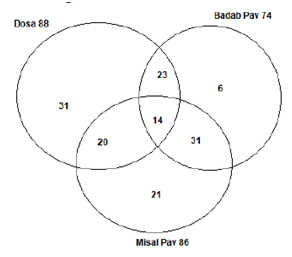 Incorrect
Incorrect
Solution (a)
Explanation:
Let cost price of the house for Raman be Rs. X.
X × [(100 – 12)/100] × [(100 + 10)/100] × [(100 – 15)/100] = 822.80 × 1000
Or X = 822.80 × 1000 × (100/88) × (100/110) × (100/85)
Or X = Rs. 10 lakhs
Thus, the cost price of the house for Raman is Rs. 10 lakhs.
Hence, option (a) is the right answer.
Explanation for Questions 28 & 29:
Venn diagram:

-
Question 35 of 35
35. Question
Jupiter tailors is making a dress. For this dress they need 1 meter of black fabric, 1.5 meters of red fabric and 0.5 meter of white fabric. Black fabric costs Rs. 950 per meter, red fabric costs Rs. 775 per meter and white fabric costs Rs.700 per meter. If they buy just enough fabric to make that dress and also pay 5% GST on the bill, then what will be the approximate amount spent by them?
Correct
Solution (d)
Explanation:
In order to figure out how much each piece of fabric costs, we need to multiply the price by the length of fabric needed.
Expenditure on black fabric = 950 x 1 = Rs.950
Expenditure on red fabric = 775 x 1.5 = Rs. 1162.5
Expenditure on white fabric = 700 x 0.5 = Rs. 350
Total bill of fabric = Rs. (950 + 1162.50 + 350) = Rs.2462.50
Total bill of fabric including 5% GST on bill = Rs. (2462.50 x 105/100) = Rs. 2585.625 Hence, option (d) is the correct answer.
Incorrect
Solution (d)
Explanation:
In order to figure out how much each piece of fabric costs, we need to multiply the price by the length of fabric needed.
Expenditure on black fabric = 950 x 1 = Rs.950
Expenditure on red fabric = 775 x 1.5 = Rs. 1162.5
Expenditure on white fabric = 700 x 0.5 = Rs. 350
Total bill of fabric = Rs. (950 + 1162.50 + 350) = Rs.2462.50
Total bill of fabric including 5% GST on bill = Rs. (2462.50 x 105/100) = Rs. 2585.625 Hence, option (d) is the correct answer.
All the Best
IASbaba

